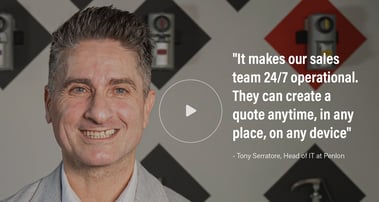Choosing the wrong solution can have significant consequences on your business, including cost overruns, decreased productivity, and frustrated customers. At the same time, choosing not to implement is a significant competitive disadvantage; your team will continue to spend excessive time on manual tasks and errors instead of building customer relationships and closing deals.
This blog will help you choose the best CPQ solution for your business by exploring the different options, their differences, and their benefits.
What is CPQ?
CPQ stands for Configure Price Quote. At its core, CPQ is a rules engine for automating the configuration, pricing, and quoting of complex customer and supplier orders. By enforcing pre-programmed business rules and thresholds, CPQ guides the quote generation process to ensure error-free configuration and pricing by automatically taking into account crucial factors. For example, product dependencies, optional features, locations, quantities, discounts, and currency and revenue types.
CPQ software covers a very broad range of features that span everything from the very simple to the highly complex involving millions of rules and dependencies. Core features include product configurations, pricing rules calculation, and quote document output, as well as customer and supplier ecommerce, or self-service. CPQ is often used in conjunction with Client Relationship Management (CRM) and Enterprise Resource Planning (ERP) platforms to ensure integrated data use and accuracy across the sales ecosystem.
Benefits of the Right CPQ Solution
In today's competitive business landscape, fast and accurate price quotes are essential for success. The right CPQ solution significantly streamlines your quoting process, improving your sales cycle efficiency, customer experience satisfaction, and bottom line.
In fact, many types of businesses implement CPQ, including capital goods and manufacturing, energy and renewables, and business services, to save time, reduce costs, and deliver fast, efficient sales growth.
- Improve Sales Efficiency: Reduce the time it takes to create accurate price quotes.
- Ensure Accuracy: Prevent configuration and pricing errors that impact margins.
- Increase Productivity: Reduce manual tasks that take time away from customers.
- Reduced Costs: Eliminate errors and reliance on key experts that cause delays.
- Increase Deal Value: Automatically upsell and cross-sell based on business rules and customer needs.
- Control and Visibility: Increase governance over day-to-day sales pipeline and operations.
- Faster Quotes: Reduce time to quote and drive faster decision-making.
- Scale and Grow: Adapt to ever-increasing sales volume, solution complexity and buyer demands.
Key Differentiators of CPQ Solutions
Ready to unlock the benefits of CPQ? By understanding the differences between solution options, you can select the right CPQ solution for your business.
Here’s what to look for:
Industry-Specific Solutions
Although sector experience might help, it won’t necessarily bring you a competitive advantage. Pricing and quoting are cross-industry processes, and many of the challenges are rarely sector-specific.
For example, while a manufacturing company sells tangible goods, such as steel and textiles, and a business services organization sells intangible goods, such as consulting and training, both sectors deliver complex sales quotes.
As all sectors seize the opportunity to add solutions to their already complex product, service or project offering mix, their challenges are the same; accurately configuring and pricing complex solutions fast.
Look for industry experience, rather than industry functionality. A vendor with experience in diverse industries brings valuable lessons learned and best practices for accelerating time to first value and future-proofing your CPQ solution.
Ability to Handle Complexity
When product and pricing complexity are high, you need a powerful CPQ solution that won’t get bogged down or crash due to complex variations and dependencies. For example, configuring a car, which has thousands of part numbers, is much more complex than configuring a table or a watch, which has just a handful of part numbers.
When product and pricing complexity is high, you need business rules that can be set-up and easily modified as formula-based rules. For example, when every product price for every customer is different, and every quote has 200 or more different products.
Define your complexity and look for a rules engine or product configurator that accommodates that level of complexity and will scale as your complexity grows.
Feature & Function Focus
A number of CPQ solutions describe themselves as “‘all-in-one solutions’.’ This typically means they provide basic Customer Relationship, Document, and Contract Management capabilities as well as CPQ capabilities. However, with so much to offer and maintain, these solutions do not always provide best-in-class features focused on CPQ.
Other CPQ solutions are "specialized solutions.” This typically means they focus on core CPQ capabilities, and partner with other best-in-class vendors to integrate specific capabilities. For example, they do not develop their own eSignature tool or CRM capabilities but develop partnerships that bring the best together in a single solution.
Define your priorities; “all-in-one” with more features but less functions, or “best-in-class” with more features and more functions. For example, look for extensive functions that support complexity, including multi-currency, discount thresholds, compliance and risk checks, and cost-plus, margin-based, and one-time pricing, as well as ecommerce and mobile-ready.
Basic Integration Capabilities
CPQ solutions typically sit between front-end Client Relationship Management (CRM) systems and Enterprise Resource Planning (ERP) platforms to ensure up-to-date data use and accuracy across the sales ecosystem.
Our customers report that the average sales rep navigates four to six different systems throughout the sales cycle. CPQ to CRM integration improves sales cycle efficiency by eliminating manual quote data entry and preventing errors. ERP to CRM integration streamlines the order-to-cash process, by automating the transform of order information from CPQ to ERP. Both also improve visibility for more informed decisions.
Look for out-of-the-box integrations to control project time and costs and API integration to accommodate evolving needs.
Advanced Integration Capabilities
Over time, your CPQ requirements will change. Take for example, the current high interest in subscriptions. If these are part of your growth strategy, it makes sense to understand how much a CPQ solution supports future business needs.
For example, it might become important to connect to a Billing Solution and/or a RevRec Solution. Or to add more visual capabilities for physical products, like cars, furniture and equipment. That’s where API integration comes in.
Consider your future goals and look for a CPQ solution that accommodates both API and out-of-the-box integration.
Key Features to Look For in a CPQ Solution
CPQ is a very broad term that spans a range of solutions, from simple, cheap apps to very sophisticated platforms. Identifying your vendor shortlist begins by asking, “Is our CPQ system goal meant as a “quick fix” or a “strategic purchase?”
- A “quick fix” might seem fine, especially if the cost is low. The danger lies in attempting to leverage the CPQ tool beyond the initial scope. Only to discover that it is not flexible enough to adapt to change and stay ahead of changing business and customer demands.
- A “strategic purchase”, on the other hand, takes your growth strategy into account, and how you will achieve this growth. Will you grow by adding new products and services? Will you require lots of new hires? A more sophisticated platform handles growing complexity, flexing with your needs to support your growth initiatives.
When selecting a CPQ solution, it's essential to consider your needs and the specific features that will best drive your goals. For example, a focus on just your sales team’s CPQ needs would be very risky without considering how the CPQ tool would cope if this process changed. A well-equipped CPQ solution will meet both today's demands and long term growth strategies.
- Product Configurations: Eliminates configuration errors, reducing time to quote.
- Pricing Calculations: Eliminates pricing errors to control margins and grow revenue.
- Quote Generation Process: Eliminates inconsistencies and expedites quotes.
- Workflow Automation: Eliminates repetitive manual tasks to free up sales teams.
- Visualization: Eliminates misunderstanding to drive faster, more informed decisions.
- CRM/ERP Integration: Eliminates manual tasks and errors, and enhances visibility.
- eCommerce: Eliminates back-and-forth communications for faster decisions.
- Guided Selling: Eliminates errors, reliance on experts, and accelerates onboarding.
Key Factors to Consider
Selecting the right CPQ system for your business is crucial for streamlining your sales process and improving efficiency. With numerous options available, it's also essential to evaluate various factors to ensure you choose the best solution for your organization.
- Scalability: Can it handle your current and future needs, including the complexity of your products, services, and pricing, as well as emerging sales strategies?
- Integration Capabilities: Can it seamlessly integrate with your existing systems, such as CRM and ERP to ease data access and eliminate errors?
- Configuration Options: Can it be configured to fit your specific business processes and workflows without pricey customization?
- Experience and Expertise: Does it come with a deep understanding of your specific business needs and a proven track record?
- User Friendliness: Is it easy for your sales reps and product team to use and understand without experts or IT.
- Pricing: What is the cost of the software, including licensing fees, implementation costs, and ongoing maintenance?
- Vendor Support: What is the vendor team like to work with, and what is the quality and responsiveness of customer support?
The Cost of Inaction
Choosing not to implement a CPQ solution can have several negative consequences for your business. Not only can it lead to increased manual quote labor, errors, and inefficiencies, but it can also put your business at a competitive disadvantage.
By not investing in CPQ, you face the potential costs of:
- Increased Manual Labor: Sales teams will spend excessive time on manual tasks that takes time away from building customer relationships and closing deals.
- Errors and Inaccuracies: Manual processes will lead to configuration and pricing rule errors that take expert input and more time to fix.
- Delayed Quotes: Slow turnaround times will slow decisions and decrease customer satisfaction which could lead to lost sales and missed opportunities.
- Inconsistent Branding: Manual document creation will lead to slower quote times, and inconsistent formatting and branding that might impact your reputation.
- Limited Insights: It will continue to be difficult to track sales performance and address bottlenecks without gathering and compiling multiple spreadsheets.
- Competitive Disadvantage: Your competition will take advantage of your inaction with their CPQ solution, responding faster, and more accurately to your customer needs.
Reduce time to quote by up to 50%
XaitCPQ is a powerful Configure, Price, Quote (CPQ) solution designed to streamline your sales process, improve efficiency, and enhance customer satisfaction. By automating manual tasks, lowering costs, and providing valuable insights, XaitCPQ empowers businesses of all sizes and complexity to achieve their sales goals.
- Robust Rules Engine: Our customer’s portfolios are complex; think thousands of products with thousands of options and variations and millions of potential configurations and bundles.
- Extensive Features and Functions: Our customers configure a wide range of core CPQ features to achieve significant time to first value. Configuration, vs customization, controls project and ongoing maintenance costs.
- Easy to Use: Our customers easily navigate our intuitive interface, and their non-technical users quickly set-up and modify their products without IT, thanks to our no-code/low code design
- Visibility: Our customers have a transparent view of their pipeline, as well as their supplier’s pipelines, and easily navigate to any account and view information as well as quotations.
- Scalability: Our customers process billions of rules every hour, enable batch edits, and work in high-availability, clustered vertical, and horizontally scaled environments. Plus, our CRM and ERP integration is their one-stop source of accurate data.
- Experience and Support: Our CPQ experts are trusted by some of the most complex businesses in the world, including, industrial equipment manufacturing, medical and IT solutions and ISO assessment and certification and other professional services.
- Results-Driven Efficiency: Our customers eliminate manual tasks and errors, control margins, risk and supplier pricing, bundle, upsell, and cross-sell, flatten the onboarding curve, and track customers as they read quotes, which helps lower costs and increase deal size.
But don’t take our word for it. Learn how FABTEK reduced their time to quote by up to 50% with XaitCPQ.
Choosing the right CPQ solution is a strategic decision that can significantly impact your business's efficiency, productivity, and overall success. By carefully evaluating factors such as scalability, integration capabilities, customization options, user-friendliness, and pricing, you can select a solution that aligns with your specific needs and provides a strong return on investment.
Remember, the right CPQ solution gives you a competitive edge by addressing today's goals as well as long term needs as market demands drive change.
See why customer users consistently score XaitCPQ a 4.5 for ease of use on Capterra.











